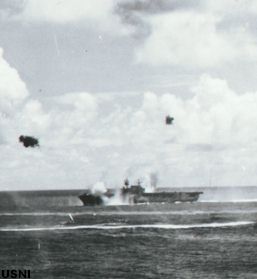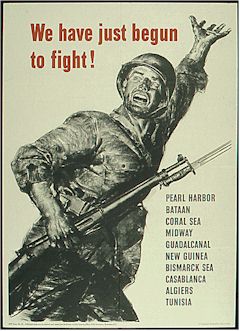
26 October 1942: Three near misses straddle Enterprise, as she and her escorts turn in wild evasive maneuvers.
History:
Prewar -
1941 -
1942 -
1943 -
1944 -
1945 -
Postwar
The Ship -
All Hands -
Decorations -
Remembrance
With the damage from the Eastern Solomons fight all too evident above and below deck, Enterprise unloaded munitions and fuel at Tongatabu, had the holes in her hull patched up, and set course for Pearl Harbor for proper repair. The cruiser Portland and four destroyers accompanied her, but her air group did not. With Japanese pressure on Guadalcanal and Port Moresby, New Guinea, growing by the day, the U.S. was desperate for air power in the South Pacific. Six fighters, six bombers, and their crews stayed with Enterprise for her protection. The rest were flown off to Wasp and Hornet, airfields in the New Hebrides, and Henderson Field on Guadalcanal.
The Big E entered Pearl Harbor on September 10, where repair crews immediately set to work on her, 24 hours a day. Not content to merely repair her wounds, the crews also replaced her old 1.1" anti-aircraft guns with 40mm Bofors quad (4 barrel) mounts. The Bofors delivered what the 1.1" could not: the power to knock a dive bomber or torpedo plane from the sky long before it had a chance to drop its ordnance. For good measure, a dozen more 20mm guns were installed as well.
 26 October 1942: Three near misses straddle Enterprise, as she and her escorts turn in wild evasive maneuvers. |
In Enterprise's absence, the situation the Solomons steadily worsened. On August 31, while Enterprise was still in Tongatabu, Saratoga was torpedoed by Japanese submarine I-26, southeast of Guadalcanal. While the damage was slight, it was enough to force her out of action for three months, while her fragile electrical drive system was repaired for the second time that year.
Hornet and the smaller carrier Wasp now formed the core of American naval power in the Solomons. But on September 15, two short weeks after Saratoga's departure, two Japanese subs ambushed the task force as it provided air cover for a transport convoy bound for Guadalcanal. Wasp caught three torpedoes at the worst possible time: just after she'd launched a patrol and her aviation fuel lines were full of gasoline. Within minutes, she was engulfed in fire and explosions; the order to abandon ship came less than an hour after the torpedoes struck.
About half an hour later, a second sub fired a spread of torpedoes at Hornet, five miles from where Wasp burned fiercely. By maneuver and luck, Hornet avoided being struck; however, one torpedo passed below her hull and struck the battleship North Carolina 500 yards away. Despite a 32 foot hole below the waterline, North Carolina maintained 25 knots and her position in formation. Minutes later, the destroyer O'Brien dodged one torpedo only to be struck by another, which practically tore her bow off. In less than an hour, two subs had destroyed a carrier, killed or wounded nearly 600 men, and forced North Carolina and O'Brien back to the West Coast for repair (O'Brien broke apart and sank during her return). Hornet was now the only operating American carrier in the Pacific.
The "Tokyo Express" from Rabaul continued landing Japanese soldiers and supplies on Guadalcanal most every night. By mid-September, the Japanese were strong enough to make another attempt to capture the Marine's Henderson Field. On September 12, General Kawaguchi Kiyotake led his men against Marine positions on a low grassy ridge south of Henderson Field, soon known as "Bloody Ridge". For two days and nights, the Japanese repeatedly assaulted the Marine line, at one point pressing it back to within 1500 yards of the precious airfield. But the Marines held, losing 40 of their own men for 600 Japanese, and by dawn September 14, the Japanese were in retreat.
By this time, a fundamental shift in Japanese strategy had taken place. Rejecting traditional principles of war, the Japanese believed the key to success on Guadalcanal was to wrest Henderson Field from the Marines, immediately begin operating from it using planes flown in from Rabaul and the carriers, and then sweep the seas clear of the American fleet. As long as the Americans could operate the airfield, they reasoned, they wouldn't be able to build up sufficient force to remove the Americans from the area altogether.
 American morale poster, from late 1942 or early 1943. |
The fighting around Guadalcanal steadily intensified. Nearly every night, more Japanese soldiers were landed on the island, and the daily air raids and nighttime bombardments from Rabaul-based planes and ships continued. The attacks were not made with impunity: between October 16-25 alone, Marine and Navy pilots downed 103 enemy planes and sank a cruiser, losing only 14 planes of their own. An encouraging event took place the night of October 11-12, when Rear Admiral Norman Scott, having drilled his force in night combat techniques for weeks, blasted a Japanese cruiser and destroyer force off Cape Esperance, west of Savo Island.
Earlier October 11, the Japanese Combined Fleet had sailed from Truk, to prowl north of the Solomons, ready to take control the seas around Guadalcanal the moment the Army announced occupation of Henderson Field. Though reinforced by the 164th Regiment of the Americal Division (U.S. Army), and a bomber squadron led by Enterprise's own LCDR Ray Davis, the U.S. positions on Guadalcanal came under severe shelling from Japanese battleships and cruisers the nights of October 14 and 15. Over half of the 90 planes at Henderson field were destroyed, and the aviation fuel was practically gone. Japanese control of the area was so complete that on the 15th they were able to land nearly 4500 troops in broad daylight.
In desperation, transport planes were called on to ferry fuel from Espiritu Santo to Guadalcanal, each flight carrying just enough aviation fuel to keep a dozen fighters aloft for an hour. Amazingly, by the afternoon, the Marine and Navy pilots were able to strike back at the Japanese, downing 17 enemy planes, and sinking three of the six transports which had landed troops that morning. That night however, the airfield again came under severe attack, as cruisers Myoko and Maya threw more than 1500 8" shells at the Marines.
In a bleak assessment of the situation, on October 15 Admiral Nimitz wrote:
"It now appears that we are unable to control the sea in the Guadalcanal area. Thus our supply of the positions will only be done at great expense to us. The situation is not hopeless, but it is certainly critical."
That same day, Nimitz reached a decision. Vice Admiral Robert L. Ghormley, Commander South Pacific Force, and his staff - competent, dedicated, but exhausted by the nearly impossible job before them - must be relieved. In Ghormley's place, Nimitz choose a man known throughout the Pacific for his fighting spirit: Vice Admiral William F. Halsey. Though Halsey departed Pearl Harbor on the 14th for Noumea, he didn't know until he stepped off the plane there what his orders were. Ghormley, while understandably disappointed to be relieved, greeted Halsey graciously, later conceding to Nimitz that he (Ghormley) was not the best man for the job at hand.
Halsey's arrival in Noumea sent American morale skyrocketing throughout the region, as did his assurances to General Alexander A. Vandegrift, the Marine commander on Guadalcanal, that the Navy would give the Marines all possible support within its means. Halsey kept his word.
Two days after Halsey's departure from Oahu, Enterprise cast away her lines, joined the fast, new battlewagon South Dakota BB-57, and raced southwest for the Solomons. All signs pointed to another major Japanese offensive. Sure enough, on October 20 the western perimeter of the American position on Guadalcanal came under assault. In Truk, Fleet Admiral Yamamoto was growing impatient with the Army commanders. For a week and a half, his ships had been sailing back and forth north of the Solomons, wasting precious fuel, waiting for the Army to capture Henderson Field. Take the airfield now, or the Combined Fleet will not have the fuel to support you, Yamamoto bluntly told General Hyakutake.
On October 23, as the Marines and Americal soldiers repelled a second violent Japanese assault, the Big E and her task force rendezvoused with Hornet east of Espiritu Santo, forming Task Force 61, under Rear Admiral Thomas Kinkaid. Halsey, anticipating a Japanese move into the waters northeast of Guadalcanal, ordered Kinkaid to sweep north of the Santa Cruz islands - a small, malaria-infested chain 700 miles north of New Caledonia - to engage the Japanese fleet.
The next night, in heavy rain, the Marines and the Americal regiment fought off still another Japanese assault. In the confusion of battle, a Japanese lookout mistakenly reported green-white-green flares, signaling that the Japanese had captured the airfield. Hyakutake, mindful of Yamamoto's impatience, immediately radioed Rabaul, which in turn notified Yamamoto that the Army had at long last taken the airfield. Within hours, the Army began backing off the early, optimistic report, but not before Yamamoto had ordered the Combined Fleet, under Vice Admiral Nobutake Kondo, to sail southeast and "annihilate" any and all American naval forces it found.
Dawn on October 25, then, found the Combined Fleet and Task Force 61 steaming aggressively towards each other, closing range at close to 30 miles every hour. Confrontation was inevitable.
Image Library -
Action Reports and Logs -
News Stories
Message Boards -
Bookstore -
Enterprise CV-6 Association
Copyright © 1998-2003 Joel Shepherd ([email protected])
Sources and Credits